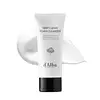What's inside
What's inside
 Key Ingredients
Key Ingredients

 Benefits
Benefits

 Concerns
Concerns

 Ingredients Side-by-side
Ingredients Side-by-side

Water
Skin ConditioningButyrospermum Parkii Butter
Skin ConditioningDecyl Glucoside
CleansingGlycerin
HumectantSodium Lauroyl Lactylate
EmulsifyingCamellia Sinensis Leaf Extract
AntimicrobialYucca Schidigera Root Extract
Skin ConditioningTocopheryl Acetate
AntioxidantRubus Idaeus Fruit Extract
AstringentVaccinium Macrocarpon Fruit Extract
AstringentCitrus Grandis Peel Oil
MaskingRubus Idaeus Seed Oil
EmollientAnanas Sativus Fruit Extract
Skin ConditioningCitrus Limon Peel Oil
MaskingCitrus Aurantifolia Oil
CleansingSodium Chloride
MaskingMangifera Indica Fruit Extract
Skin ConditioningCocamidopropyl Hydroxysultaine
CleansingLeuconostoc/Radish Root Ferment Filtrate
AntimicrobialBenzyl Alcohol
PerfumingCaprylhydroxamic Acid
Hamamelis Virginiana Water
AstringentAlcohol
AntimicrobialSodium Hydroxide
BufferingParfum
MaskingWater, Butyrospermum Parkii Butter, Decyl Glucoside, Glycerin, Sodium Lauroyl Lactylate, Camellia Sinensis Leaf Extract, Yucca Schidigera Root Extract, Tocopheryl Acetate, Rubus Idaeus Fruit Extract, Vaccinium Macrocarpon Fruit Extract, Citrus Grandis Peel Oil, Rubus Idaeus Seed Oil, Ananas Sativus Fruit Extract, Citrus Limon Peel Oil, Citrus Aurantifolia Oil, Sodium Chloride, Mangifera Indica Fruit Extract, Cocamidopropyl Hydroxysultaine, Leuconostoc/Radish Root Ferment Filtrate, Benzyl Alcohol, Caprylhydroxamic Acid, Hamamelis Virginiana Water, Alcohol, Sodium Hydroxide, Parfum
Water
Skin ConditioningMyristic Acid
CleansingGlycerin
HumectantMethylpropanediol
SolventPotassium Hydroxide
BufferingCoco-Glucoside
CleansingLauric Acid
CleansingPalmitic Acid
EmollientStearic Acid
CleansingGlyceryl Stearate
EmollientLaminaria Japonica Extract
Skin ProtectingEclipta Prostrata Leaf Extract
Skin ConditioningCentella Asiatica Extract
CleansingFicus Carica Fruit Extract
HumectantAnastatica Hierochuntica Extract
AstringentSapindus Mukorossi Fruit Extract
Skin ConditioningSaponaria Officinalis Leaf Extract
AntimicrobialUlmus Davidiana Root Extract
Skin ConditioningAmaranthus Caudatus Seed Extract
Skin ConditioningTuber Magnatum Extract
Skin ConditioningGlycine Soja Seed Extract
Skin ConditioningTremella Fuciformis Extract
HumectantAloe Barbadensis Leaf Extract
EmollientAlthaea Rosea Flower Extract
Skin ConditioningViscum Album Fruit Extract
SoothingNymphaea Alba Flower Extract
Skin ConditioningHydrogenated Lecithin
EmulsifyingOenothera Biennis Oil
EmollientGlycine Soja Oil
EmollientCamellia Japonica Seed Oil
EmollientMacadamia Ternifolia Seed Oil
EmollientPersea Gratissima Oil
Skin ConditioningOlea Europaea Fruit Oil
MaskingHelianthus Annuus Seed Oil
EmollientHippophae Rhamnoides Fruit Oil
Skin ProtectingPotassium Cocoyl Glycinate
Salicylic Acid
MaskingSorbitan Olivate
EmulsifyingButylene Glycol
HumectantDisodium EDTA
Fructooligosaccharides
HumectantDipropylene Glycol
HumectantBeta-Glucan
Skin ConditioningPanthenol
Skin ConditioningHydrolyzed Hyaluronic Acid
HumectantSodium Palmitoyl Proline
Skin ConditioningGluconolactone
Skin ConditioningCeramide NP
Skin ConditioningIllite
AbrasiveTocopherol
AntioxidantKaolin
AbrasiveMontmorillonite
Absorbent1,2-Hexanediol
Skin ConditioningParfum
MaskingEthylhexylglycerin
Skin ConditioningHexyl Cinnamal
PerfumingLimonene
PerfumingLinalool
PerfumingBenzyl Benzoate
AntimicrobialWater, Myristic Acid, Glycerin, Methylpropanediol, Potassium Hydroxide, Coco-Glucoside, Lauric Acid, Palmitic Acid, Stearic Acid, Glyceryl Stearate, Laminaria Japonica Extract, Eclipta Prostrata Leaf Extract, Centella Asiatica Extract, Ficus Carica Fruit Extract, Anastatica Hierochuntica Extract, Sapindus Mukorossi Fruit Extract, Saponaria Officinalis Leaf Extract, Ulmus Davidiana Root Extract, Amaranthus Caudatus Seed Extract, Tuber Magnatum Extract, Glycine Soja Seed Extract, Tremella Fuciformis Extract, Aloe Barbadensis Leaf Extract, Althaea Rosea Flower Extract, Viscum Album Fruit Extract, Nymphaea Alba Flower Extract, Hydrogenated Lecithin, Oenothera Biennis Oil, Glycine Soja Oil, Camellia Japonica Seed Oil, Macadamia Ternifolia Seed Oil, Persea Gratissima Oil, Olea Europaea Fruit Oil, Helianthus Annuus Seed Oil, Hippophae Rhamnoides Fruit Oil, Potassium Cocoyl Glycinate, Salicylic Acid, Sorbitan Olivate, Butylene Glycol, Disodium EDTA, Fructooligosaccharides, Dipropylene Glycol, Beta-Glucan, Panthenol, Hydrolyzed Hyaluronic Acid, Sodium Palmitoyl Proline, Gluconolactone, Ceramide NP, Illite, Tocopherol, Kaolin, Montmorillonite, 1,2-Hexanediol, Parfum, Ethylhexylglycerin, Hexyl Cinnamal, Limonene, Linalool, Benzyl Benzoate
Ingredients Explained
These ingredients are found in both products.
Ingredients higher up in an ingredient list are typically present in a larger amount.
Glycerin is already naturally found in your skin. It helps moisturize and protect your skin.
A study from 2016 found glycerin to be more effective as a humectant than AHAs and hyaluronic acid.
As a humectant, it helps the skin stay hydrated by pulling moisture to your skin. The low molecular weight of glycerin allows it to pull moisture into the deeper layers of your skin.
Hydrated skin improves your skin barrier; Your skin barrier helps protect against irritants and bacteria.
Glycerin has also been found to have antimicrobial and antiviral properties. Due to these properties, glycerin is often used in wound and burn treatments.
In cosmetics, glycerin is usually derived from plants such as soybean or palm. However, it can also be sourced from animals, such as tallow or animal fat.
This ingredient is organic, colorless, odorless, and non-toxic.
Glycerin is the name for this ingredient in American English. British English uses Glycerol/Glycerine.
Learn more about GlycerinParfum is a catch-all term for an ingredient or more that is used to give a scent to products.
Also called "fragrance", this ingredient can be a blend of hundreds of chemicals or plant oils. This means every product with "fragrance" or "parfum" in the ingredients list is a different mixture.
For instance, Habanolide is a proprietary trade name for a specific aroma chemical. When used as a fragrance ingredient in cosmetics, most aroma chemicals fall under the broad labeling category of “FRAGRANCE” or “PARFUM” according to EU and US regulations.
The term 'parfum' or 'fragrance' is not regulated in many countries. In many cases, it is up to the brand to define this term.
For instance, many brands choose to label themselves as "fragrance-free" because they are not using synthetic fragrances. However, their products may still contain ingredients such as essential oils that are considered a fragrance by INCI standards.
One example is Calendula flower extract. Calendula is an essential oil that still imparts a scent or 'fragrance'.
Depending on the blend, the ingredients in the mixture can cause allergies and sensitivities on the skin. Some ingredients that are known EU allergens include linalool and citronellol.
Parfum can also be used to mask or cover an unpleasant scent.
The bottom line is: not all fragrances/parfum/ingredients are created equally. If you are worried about fragrances, we recommend taking a closer look at an ingredient. And of course, we always recommend speaking with a professional.
Learn more about ParfumWater. It's the most common cosmetic ingredient of all. You'll usually see it at the top of ingredient lists, meaning that it makes up the largest part of the product.
So why is it so popular? Water most often acts as a solvent - this means that it helps dissolve other ingredients into the formulation.
You'll also recognize water as that liquid we all need to stay alive. If you see this, drink a glass of water. Stay hydrated!
Learn more about Water